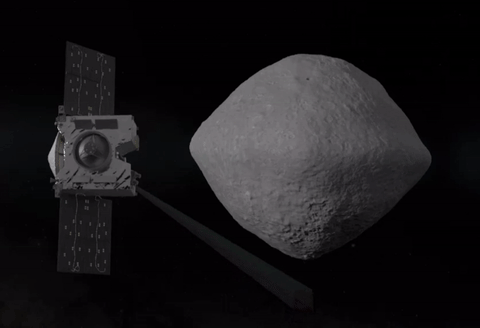NASA Is About to Launch a Daring Mission to Intercept a Near-Earth Asteroid
A spacecraft will be tasked to study how life was formed in the solar system and how to protect life from the asteroid itself.

Graphic showing the OSIRIS-REx Spacecraft surveying asteroid Bennu. (Credit: NASA)
KENNEDY SPACE CENTER, Fla.—For the first time in its history, NASA is launching an audacious long-term mission to intercept an asteroid and gather samples for return to Earth. The spacecraft, dubbed OSIRIS-REx, is currently in final preparations for launch from Cape Canaveral.
OSIRIS-REx will launch on September 8 on a ULA Atlas V rocket for a journey that will span more than seven years, taking two years just until it reaches its target: a carbon-rich asteroid named Bennu. Scientists selected Bennu as it may contain materials that existed during the birth of the solar system—a distinct feature that could provide clues to how life formed here on Earth.
“Sample return is what this mission is all about getting the material here in our laboratories so we can do the detailed investigations to address some fundamental questions,” said John Loiacono, OSIRIS-REx deputy project manager during a briefing at Kennedy Space Center. “We’re looking at the carbon-rich asteroids and our target Bennu falls into this category. We believe these hold precious organic molecules that were the precursors to life on our planet.”
Researchers also intend to study the potential for a catastrophic impact by Bennu and similar small bodies on Earth. The asteroid, about 1,600 feet in diameter and traveling at 63,000 mph, comes relatively close to Earth every six years. In the year 2135, Bennu is expected to come within 186,000 miles—closer to Earth than the Moon.

A size comparison of asteroid Bennu. (Image: NASA)
“Bennu was chosen because it’s accessible and its orbit is so much like ours. Because of its size, we are able to do this detailed survey and mapping. We’re actually able to go up and touch the asteroid. It rotates at such a rate that we can actually do a safe collection of that sample,” Dr. Christina Richey, deputy program scientist at NASA, told the Observer.
When it comes to any danger posed by Bennu, Dr. Richey says we can breathe easy for now as it has very little chance of hitting Earth. In fact, studying how these bodies move is crucial to one day foreseeing (or even preventing) these kinds of threats. NASA intends to do this by studying the Yarkovsky Effect, which governs the trajectory of Bennu and similarly sized objects.
Mission Timeline
On September 8, OSIRIS-REx will launch from Cape Canaveral atop a United Launch Alliance Atlas V rocket propelling it to an escape velocity of around 12,000 mph. The liftoff window opens at 7:05 p.m. for two hours.
After breaking orbit, the spacecraft will travel around the Sun for a year until doing a flyby of Earth while using its gravity and orbital forces to slingshot toward Bennu.
In August of 2018, after completing two years of travel, OSIRIS-Rex will start making its approach toward Bennu with a distance of 2 million kilometers between the them. The spacecraft will use its small thrusters to match the speed of Bennu’s orbit around the Sun.
Beginning in October 2018, OSIRIS-REx will begin surveying Bennu for signs of asteroid plumes and natural satellites. It will also begin measuring the Yarkovsky acceleration of Bennu.

Dr. Christina Richey holds a model of the asteroid Bennu along with a sketch of the OSIRIS-REx intercept trajectory. (Photo: Robin Seemangal)
“We’re going to start to understand the Yarkovsky effect better. How it actually changes the orbits of these small bodies. We’re actually going to bring back that data to put into models to test these theories and improve those models,” explained Dr. Richey. “This will make it easier to understand how all small bodies and all these different asteroids in the solar system are moving. This is critical for us. We want to understand why the Yarkovsky effect changes the way it does.”
After spending 505 days mapping the asteroid and choosing an ideal location to retrieve a sample, OSIRIS-REx will do just that. Without landing on the asteroid, the spacecraft will be close enough to extend a robotic arm that will shoot a pressurized burst of nitrogen to kick up rocks and particles on the surface while grabbing some of that material in an air filter. The window for this activity is five seconds, and there is enough nitrogen on board to try twice more if needed.

raphic showing OSIRIS-REx’s robotic arm collecting a sample from asteroid Bennu. (Credit: NASA)
After March 2021, OSIRIS-REx can begin its journey home with at least 60 grams of regolith material. The spacecraft will fire its thrusters and push away from Bennu at around 716 mph.
In September of 2023, OSIRIS-REx’s trajectory will intersect with Earth’s orbit.
OSIRIS-REx will then detach the sample return capsule and send it barreling toward Earth while the spacecraft pushes away and into a stable orbit around the Sun. The capsule will begin entry into the atmosphere at about 27,738 mph. Its heat shield will ensure the safety and integrity of the samples.
On September 24, 2023, after OSIRIS-REx’s seven-year journey, NASA is expecting to collect its cargo after the sample return capsule free falls for a touchdown in the Utah desert.
Robin Seemangal focuses on NASA and advocacy for space exploration. He was born and raised in Brooklyn, where he currently resides. Find him on Instagram for more space-related content: @nova_road.
NASA == Not A Space Agency
Not nice and so true ; (
/ hugz ; )
Can I dial that Cell phone number on the white board ?
: )
/ hugz ; )
The above comment should be taken as " POR " , ' Proof Of Read ' is sort of like ' POW ' = proof of work ; )
Ha Ha HA; yes I know, funny : )